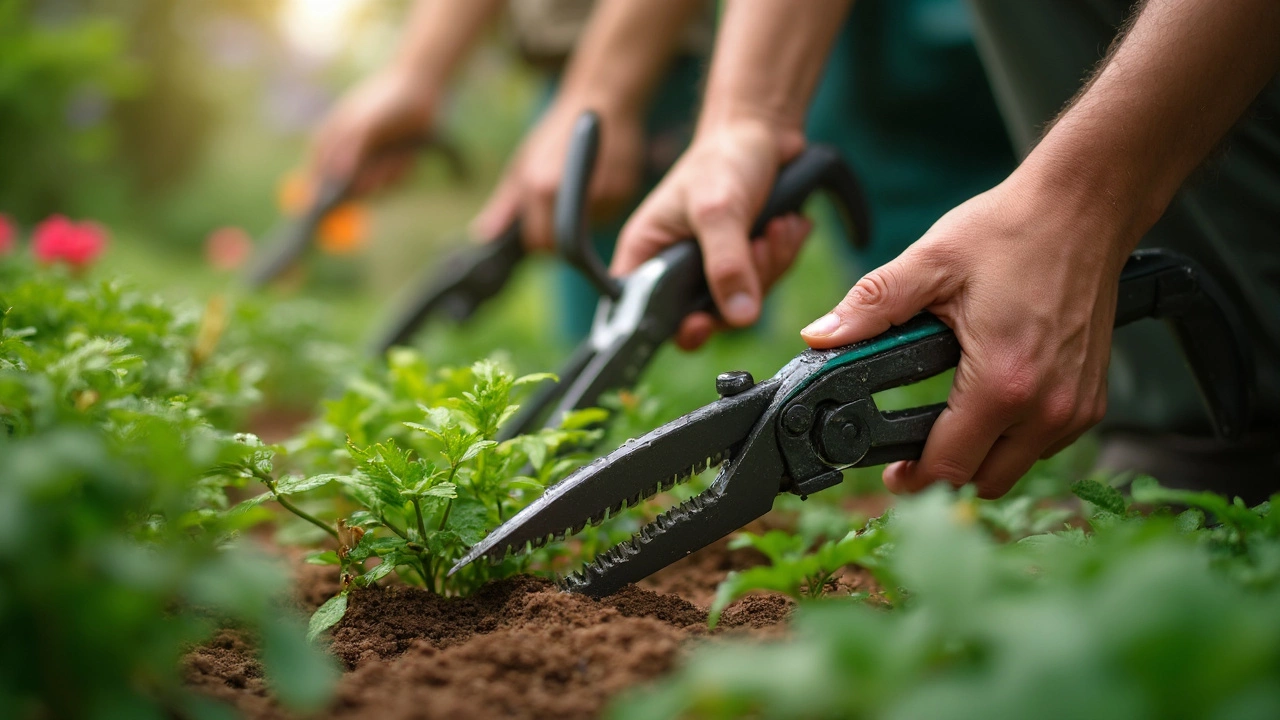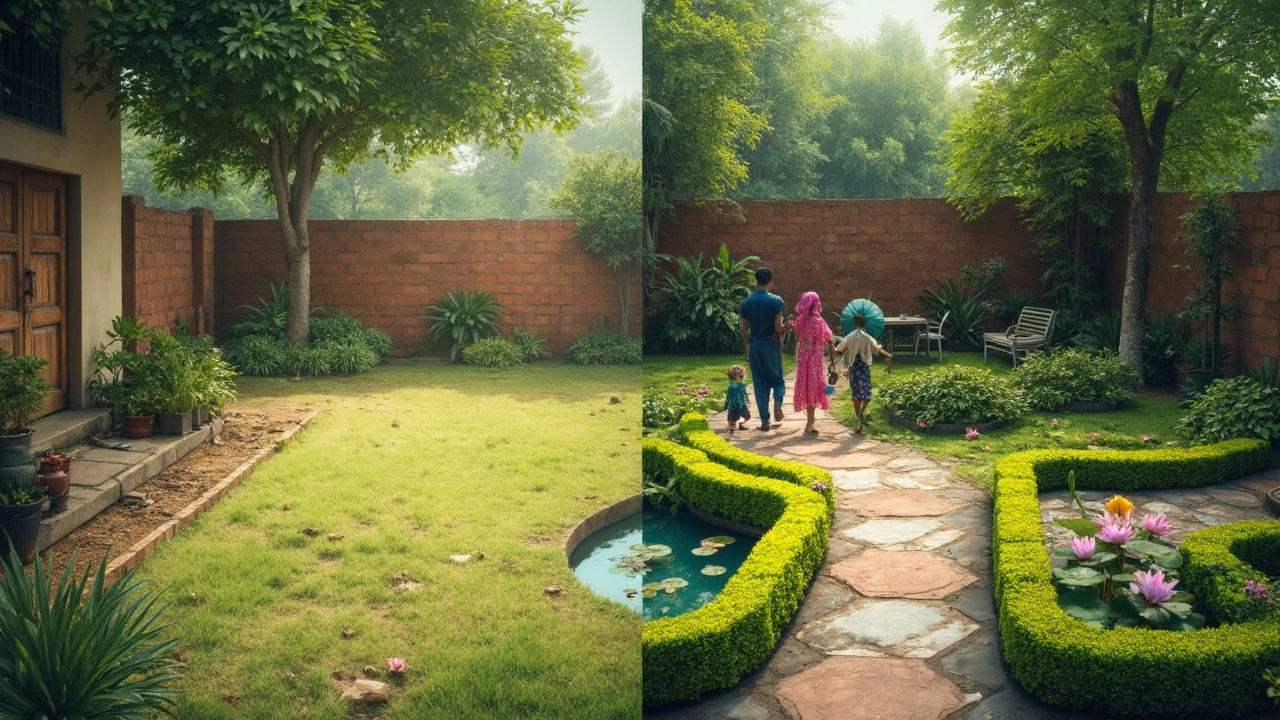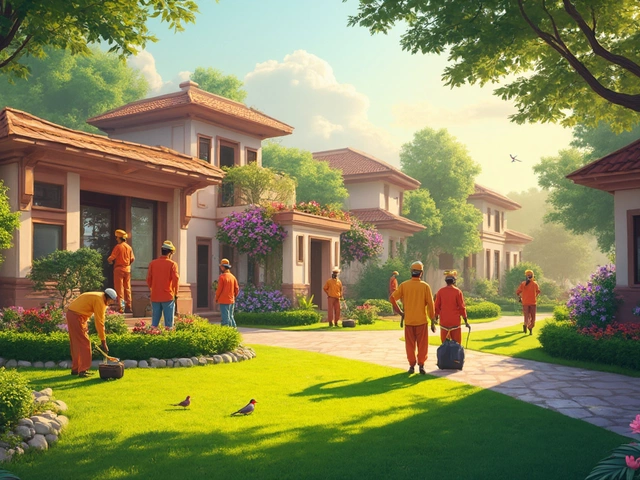If you think landscapers just mow grass, you’re missing most of the picture. Landscapers are like outdoor handymen—they handle everything from planting trees to putting in walkways, even keeping bugs away from your veggie patch. These pros shape spaces you actually want to spend time in, and it’s more hands-on work than most people guess.
Hiring a landscaper isn’t just about saving time on weekend chores. A good one helps you dodge rookie mistakes, like picking the wrong plants for your area or flooding your garden with bad sprinkler choices. Wondering if you need regular visits or just a one-time fix-up? It’s smart to know what these folks really do before you call them in. You’ll make better choices and get more value for your money.
- Landscaping Basics: What’s in the Job?
- Tools of the Trade: Equipment and Skills
- Not Just Mowing: The Range of Services
- Choosing the Right Landscaper
- Pro Tips for Getting More from Your Yard
Landscaping Basics: What’s in the Job?
Landscaping isn’t just about making grass look neat. Guys and gals in this field handle everything that helps yards and gardens thrive—design, hard work, even a bit of science. You’ll see landscapers tackling big and small projects, but the end goal is always the same: making outdoor spaces look better and work better for the people using them.
Here’s what you’ll usually find on a landscaper’s job list:
- Landscaper design: Mapping out the layout for plant beds, lawns, patios, or water features.
- Soil prep: Testing soil and getting it ready so plants actually survive (not just look good for a week).
- Planting: Trees, shrubs, flowers—putting the right stuff in the right spot for your climate.
- Lawn care: Not just mowing, but edging, aerating, and fixing patchy spots.
- Mulching and fertilizing: Keeping weeds down and helping new stuff grow strong.
- Irrigation: Setting up and fixing sprinkler or drip systems so nothing gets thirsty or drowned.
- Cleanup: Clearing leaves, pulling weeds, hauling away branches after storms.
Most landscapers know what grows well in your area. For example, according to the U.S. Bureau of Labor Statistics, there were about 1.3 million landscaping and groundskeeping workers as of 2023. That’s a lot of yards getting professional TLC.
| Task | How Often Done |
|---|---|
| Mowing lawns | Weekly during growing season |
| Trimming hedges | Monthly or as needed |
| Mulching beds | 1-2 times per year |
| Planting flowers | Spring and fall |
| Leaf cleanup | Every fall, sometimes spring |
So the next time you see a landscaping crew, remember they’re doing a lot more than just running a mower. They’re juggling design, maintenance, and even plant health—all so you can have a yard that doesn’t just look better, but actually works better too.
Tools of the Trade: Equipment and Skills
You can spot a real landscaper by the gear they haul in. Sure, you’ll see the standard mower and trimmer, but that’s just the tip of the iceberg. The job calls for a mix of muscle and the right tools—both can make or break how your yard ends up looking.
- Landscapers use commercial-grade mowers, which cut grass twice as fast as basic home models. These machines aren’t cheap, but they give a cleaner finish—plus, they handle big yards with ease.
- Edgers and trimmers are must-haves for crisp lines along sidewalks and flower beds. That clean look is tough to pull off without them.
- Leaf blowers and vacuums speed up fall cleanup way more than rakes ever could.
- For planting, they bring digging bars, augers, and spades. Picking the right tool cuts down on root damage and means plants get the best start.
- When building patios or walkways, you’ll see compactors, brick saws, and laser levels. These keep things strong and safe, so nothing shifts over time.
On the skills side, it’s not just about knowing how to run a machine. Landscapers keep up with basics in plant science, soil health, and even pest control. Many go through certification programs or apprenticeships—some states actually require a license for bigger projects.
Here’s a quick look at how the right tools and skills can save you time and cash:
| Tool or Skill | Benefit |
|---|---|
| Commercial Mower | Finishes 1 acre in half the time of a standard mower |
| Soil Testing | Helps avoid dead plants—one soil test can save you from replanting whole beds |
| Certified Pest Control | Keeps lawns healthy without wrecking local wildlife |
Don’t forget safety gear, either. Landscapers wear gloves, eye protection, and steel-toed boots for good reason. Professional crews usually spend over $1,000 a year keeping their equipment sharp, safe, and ready—skipping this step is how accidents (and bad results) happen.

Not Just Mowing: The Range of Services
It’s a huge mistake to think a landscaper’s job stops at mowing lawns. These folks offer all kinds of practical services that go way beyond the basics. In fact, lawn mowing usually only scratches the surface of what they handle on any given week.
Here’s a quick look at the most common services a landscaper can tackle:
- Lawn care: Regular mowing, edging, aerating, fertilizing, reseeding, and pest control keep grass looking sharp and healthy all year.
- Planting and garden beds: Landscapers select, plant, and care for trees, flowers, shrubs, and even veggie gardens. They know what grows best in your local conditions.
- Irrigation setup and fixes: They install new sprinkler systems, repair old ones, and adjust watering schedules to save water and money.
- Mulching and soil work: Adding mulch, amending soil, and dealing with weeds is all part of the gig. Mulch isn’t just about looks—it actually helps plants survive tough weather.
- Hardscaping: This means patios, stone paths, retaining walls, and even built-in fire pits. Landscapers use all sorts of materials, from flagstone to pavers.
- Seasonal cleanup: Spring and fall cleanups, leaf removal, pruning, and prepping the garden for summer or winter can make a big difference.
- Landscape design: Some landscapers specialize in drawing up custom designs—think blueprints for your backyard.
Did you know about 69% of landscape companies in the U.S. now offer design-build services? That’s where they not only plan but also build out the whole project, so you don’t need to juggle different contractors.
| Service | How Often Needed | Value Added |
|---|---|---|
| Mowing | Weekly/Bi-weekly | Keeps yard neat |
| Mulching | Once or twice a year | Reduces weeds, holds moisture |
| Landscape Design | As needed | Custom look, improves home value |
| Planting | Seasonal | Year-round color and greenery |
| Irrigation | Ongoing maintenance | Saves water, prevents dead zones |
So if you’ve only called in a landscaper for the grass, you’re probably leaving some serious yard potential on the table. These pros can help turn plain outdoor space into something you’d actually show off on a Saturday afternoon.
Choosing the Right Landscaper
Picking a landscaper isn’t just about price or a flashy truck. You want someone who actually knows what they’re doing in your climate and who’ll treat your yard like it’s their own. Start by checking if they’re insured—this protects you if something goes sideways on your property. Most reputable companies will show proof of insurance and, in many states, a license is a must for certain landscaping work, especially anything with chemicals or big construction.
Ask for examples of recent jobs. Look for before-and-afters or even quick video walk-throughs. It’s a red flag if they can’t show proof of their work. You should also get a written estimate with a clear breakdown. A real pro doesn’t ballpark costs over text.
It also pays to grill them a bit. Here are some quick questions that tell you a lot:
- "What’s your experience with projects like mine?" (Their answer tells you if you’re a test case or a routine job.)
- "Who handles the work—your team or subcontractors?" (Quality can slip when jobs are handed off.)
- "What plants and materials do you recommend here and why?" (You want someone who knows what thrives locally, not just what looks pretty in photos.)
- "How do you handle issues like weeds, pests, or drainage?" (Watch for vague answers—they should be specific.)
- "Can I contact a couple of recent clients for feedback?" (Solid landscapers have loyal customers happy to talk.)
If you care about the environment, check whether they use native plants or avoid nasty pesticides. Some will even show you their plan to keep water use down, which matters more than ever these days.
Let’s look at some quick numbers. According to a 2024 survey by the National Association of Landscape Professionals, 71% of homeowners who hired pros said ongoing communication was the number-one factor in their satisfaction. Also, jobs done by licensed and insured landscapers took 15% less time on average due to fewer project hiccups.
| What to Check | Why It Matters |
|---|---|
| Insurance & License | If accidents or damage happen, you’re covered. Also shows they’re legit. |
| References & Portfolio | Proof of skill—seeing is believing. |
| Knowledge of Local Plants | Not every plant works everywhere; local knowledge means better results. |
| Written Estimate | Helps avoid payment surprises or extra charges later. |
| Communication | Smoother projects, fewer headaches, and you stay in the loop. |
Don’t just Google “landscaper near me” and call the first number. Take an hour to ask questions, check references, and get things in writing. You’ll end up with a yard you love—and a lot less stress.

Pro Tips for Getting More from Your Yard
Making the most out of your yard isn’t about dropping loads of cash or buying fancy decorations. Small, smart changes go a long way. Here’s what landscapers say makes the biggest difference, and these tips aren’t just guesses—they’re backed by what actually works in real backyards.
First, go native. Pick plants that belong in your region. They need less water, bounce back from rough weather, and invite local birds and bees—better for everyone. For example, if you’re in Texas, try bluebonnets or sage; for the Northeast, think black-eyed Susans or ferns. Local garden centers can point you in the right direction.
Ditch the endless fight against weeds by mulching well. Mulch holds in soil moisture and makes weeds think twice about popping up. As a bonus, it keeps soil temps steady, which your plants love. Try spreading two to three inches around trees, flowers, and shrubs, but keep it away from touching the stems directly.
If your grass always seems patchy or brown, check your mower height. Most people cut their lawns too short. Landscapers say to keep grass about three inches high. Taller grass shades the soil, which helps stop weeds and holds moisture. And always switch the mowing direction each time—this keeps lawn compact, not rutted.
Don’t forget about lighting. Even a few low-voltage lights along your walkway or near the deck make the yard safer and more inviting after dark. Solar options make setup easy—no electricians needed.
- Plan for zones: group plants with similar water needs.
- Water early in the morning, not at night, to head off fungus and waste.
- Consider low-maintenance options like clover or no-mow grass to save hassle and money.
- Talk to your landscaper about soil testing. You’d be surprised how much difference a little compost or lime can make once you know what your yard actually needs.
- Make room to relax: add a bench, a hammock, or a small fire pit. It doesn’t have to be complicated—focus on spots where you’ll actually want to hang out.
Small tweaks pile up fast. Each smart change gives you more free time and a yard you’ll actually use—not just mow.

Write a comment